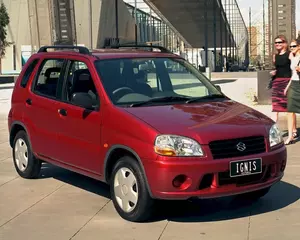
| Vehicle | Curb weight | Difference from world's smallest | Weight to power ratio | 0—60 mph acceleration ratio | Consumption ratio |
|---|---|---|---|---|---|
| 1.2 Dualjet |
925 kg / 2040 lbs |
500 kg (1103 lbs) heavier | 11 kg to 1 hp | 78 kg/s (172 lbs/s) | - |
| 1.2 |
890 kg / 1962 lbs |
465 kg (1025 lbs) heavier | 10 kg to 1 hp | - | - |
| Vehicle | 1.2 Dualjet |
|---|---|
| Curb weight |
925 kg / 2040 lbs |
| Difference from world's smallest | 500 kg (500 lbs) heavier |
| Weight to power ratio | 11 kg to 1 hp |
| 0—60 mph acceleration ratio | 78 kg/s (172 lbs/s) |
| Consumption ratio | - |
| Vehicle | 1.2 |
| Curb weight |
890 kg / 1962 lbs |
| Difference from world's smallest | 465 kg (465 lbs) heavier |
| Weight to power ratio | 10 kg to 1 hp |
| 0—60 mph acceleration ratio | - |
| Consumption ratio | - |

| Vehicle | Curb weight | Difference from world's smallest | Weight to power ratio | 0—60 mph acceleration ratio | Consumption ratio |
|---|---|---|---|---|---|
| 1.2 DualJet |
835 kg / 1841 lbs |
410 kg (904 lbs) heavier | 9 kg to 1 hp | 75 kg/s (165 lbs/s) |
194 kg/L (428 lbs/L) |
| Vehicle | 1.2 DualJet |
|---|---|
| Curb weight |
835 kg / 1841 lbs |
| Difference from world's smallest | 410 kg (410 lbs) heavier |
| Weight to power ratio | 9 kg to 1 hp |
| 0—60 mph acceleration ratio | 75 kg/s (165 lbs/s) |
| Consumption ratio |
194 kg/L (428 lbs/L) |

| Vehicle | Curb weight | Difference from world's smallest | Weight to power ratio | 0—60 mph acceleration ratio | Consumption ratio |
|---|---|---|---|---|---|
| 1.5 i 16V |
1015 kg / 2238 lbs |
590 kg (1301 lbs) heavier | 10 kg to 1 hp | 97 kg/s (214 lbs/s) | - |
| 1.3 DDiS |
1025 kg / 2260 lbs |
600 kg (1323 lbs) heavier | 15 kg to 1 hp | 72 kg/s (159 lbs/s) | - |
| 1.3 i 16V |
1005 kg / 2216 lbs |
580 kg (1279 lbs) heavier | 11 kg to 1 hp | - | - |
| Vehicle | 1.5 i 16V |
|---|---|
| Curb weight |
1015 kg / 2238 lbs |
| Difference from world's smallest | 590 kg (590 lbs) heavier |
| Weight to power ratio | 10 kg to 1 hp |
| 0—60 mph acceleration ratio | 97 kg/s (214 lbs/s) |
| Consumption ratio | - |
| Vehicle | 1.3 DDiS |
| Curb weight |
1025 kg / 2260 lbs |
| Difference from world's smallest | 600 kg (600 lbs) heavier |
| Weight to power ratio | 15 kg to 1 hp |
| 0—60 mph acceleration ratio | 72 kg/s (159 lbs/s) |
| Consumption ratio | - |
| Vehicle | 1.3 i 16V |
| Curb weight |
1005 kg / 2216 lbs |
| Difference from world's smallest | 580 kg (580 lbs) heavier |
| Weight to power ratio | 11 kg to 1 hp |
| 0—60 mph acceleration ratio | - |
| Consumption ratio | - |

| Vehicle | Curb weight | Difference from world's smallest | Weight to power ratio | 0—60 mph acceleration ratio | Consumption ratio |
|---|---|---|---|---|---|
| 1.3 i |
755 kg / 1665 lbs |
330 kg (728 lbs) heavier | 9 kg to 1 hp | 61 kg/s (135 lbs/s) |
135 kg/L (298 lbs/L) |
| 1.0 i |
750 kg / 1654 lbs |
325 kg (717 lbs) heavier | 14 kg to 1 hp | 49 kg/s (108 lbs/s) |
153 kg/L (337 lbs/L) |
| 1.3 i GLS |
825 kg / 1819 lbs |
400 kg (882 lbs) heavier | 12 kg to 1 hp | - | - |
| Vehicle | 1.3 i |
|---|---|
| Curb weight |
755 kg / 1665 lbs |
| Difference from world's smallest | 330 kg (330 lbs) heavier |
| Weight to power ratio | 9 kg to 1 hp |
| 0—60 mph acceleration ratio | 61 kg/s (135 lbs/s) |
| Consumption ratio |
135 kg/L (298 lbs/L) |
| Vehicle | 1.0 i |
| Curb weight |
750 kg / 1654 lbs |
| Difference from world's smallest | 325 kg (325 lbs) heavier |
| Weight to power ratio | 14 kg to 1 hp |
| 0—60 mph acceleration ratio | 49 kg/s (108 lbs/s) |
| Consumption ratio |
153 kg/L (337 lbs/L) |
| Vehicle | 1.3 i GLS |
| Curb weight |
825 kg / 1819 lbs |
| Difference from world's smallest | 400 kg (400 lbs) heavier |
| Weight to power ratio | 12 kg to 1 hp |
| 0—60 mph acceleration ratio | - |
| Consumption ratio | - |

| Vehicle | Curb weight | Difference from world's smallest | Weight to power ratio | 0—60 mph acceleration ratio | Consumption ratio |
|---|---|---|---|---|---|
| 1.3 i 16V |
845 kg / 1863 lbs |
420 kg (926 lbs) heavier | 10 kg to 1 hp | 66 kg/s (146 lbs/s) | - |
| 1.3 i 16V 4WD |
995 kg / 2194 lbs |
570 kg (1257 lbs) heavier | 12 kg to 1 hp | - |
144 kg/L (318 lbs/L) |
| 1.5 i 16V Sport |
935 kg / 2062 lbs |
510 kg (1125 lbs) heavier | 9 kg to 1 hp | 110 kg/s (243 lbs/s) | - |
| 1.3 i GLX |
845 kg / 1863 lbs |
420 kg (926 lbs) heavier | 12 kg to 1 hp | - | - |
| Vehicle | 1.3 i 16V |
|---|---|
| Curb weight |
845 kg / 1863 lbs |
| Difference from world's smallest | 420 kg (420 lbs) heavier |
| Weight to power ratio | 10 kg to 1 hp |
| 0—60 mph acceleration ratio | 66 kg/s (146 lbs/s) |
| Consumption ratio | - |
| Vehicle | 1.3 i 16V 4WD |
| Curb weight |
995 kg / 2194 lbs |
| Difference from world's smallest | 570 kg (570 lbs) heavier |
| Weight to power ratio | 12 kg to 1 hp |
| 0—60 mph acceleration ratio | - |
| Consumption ratio |
144 kg/L (318 lbs/L) |
| Vehicle | 1.5 i 16V Sport |
| Curb weight |
935 kg / 2062 lbs |
| Difference from world's smallest | 510 kg (510 lbs) heavier |
| Weight to power ratio | 9 kg to 1 hp |
| 0—60 mph acceleration ratio | 110 kg/s (243 lbs/s) |
| Consumption ratio | - |
| Vehicle | 1.3 i GLX |
| Curb weight |
845 kg / 1863 lbs |
| Difference from world's smallest | 420 kg (420 lbs) heavier |
| Weight to power ratio | 12 kg to 1 hp |
| 0—60 mph acceleration ratio | - |
| Consumption ratio | - |